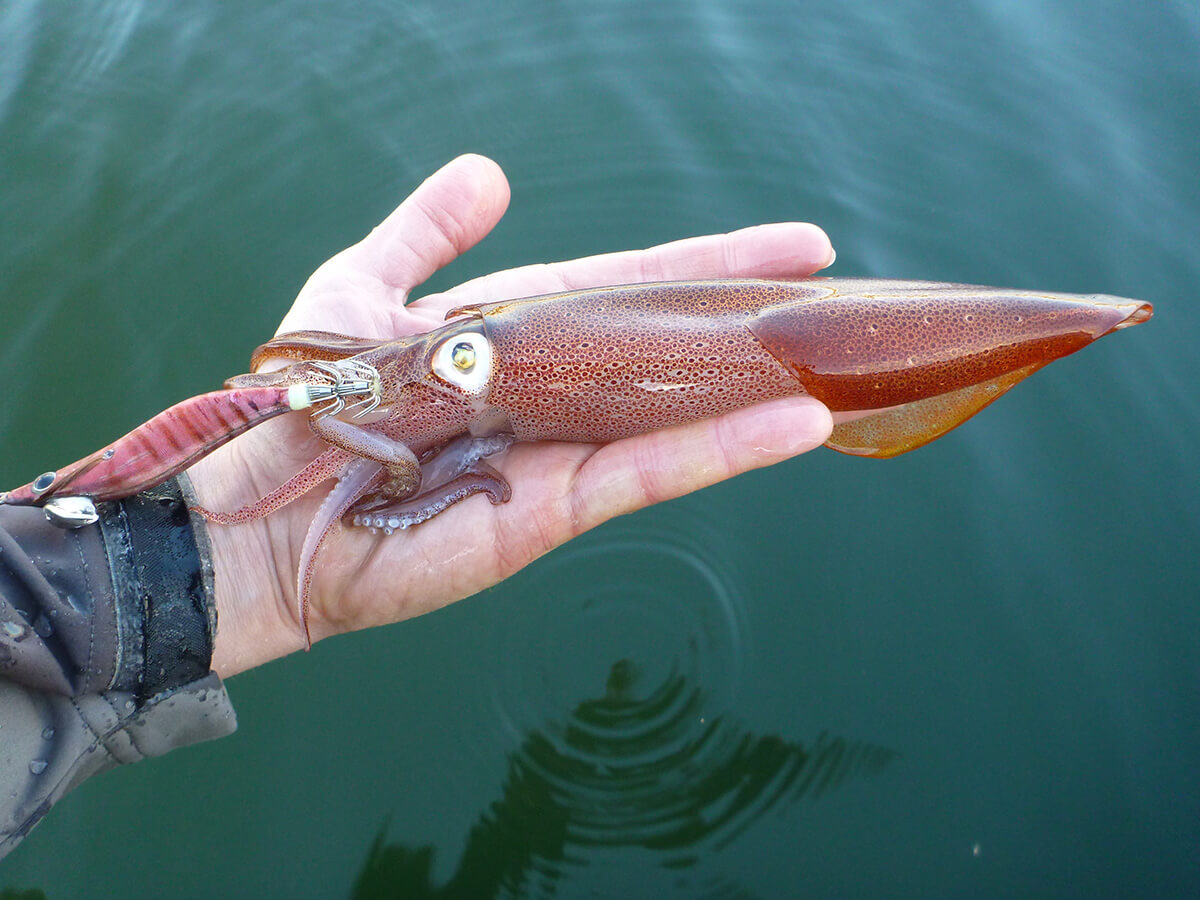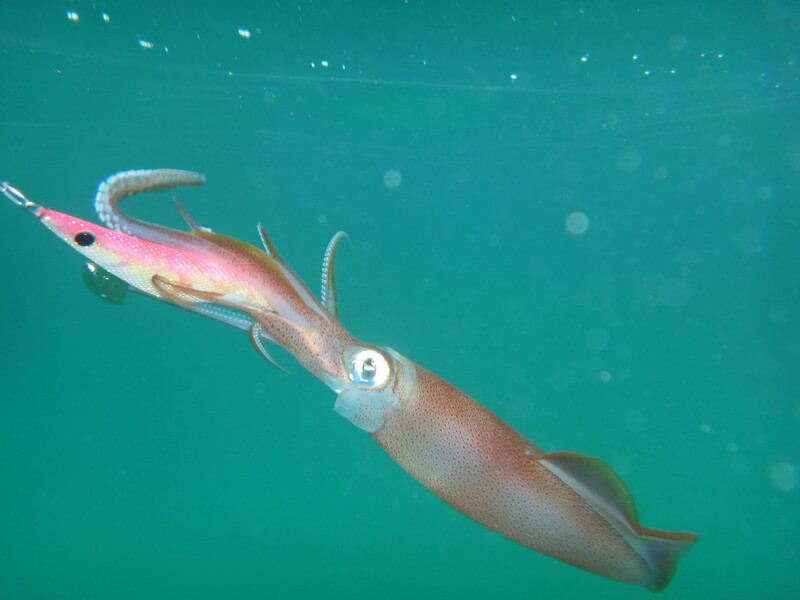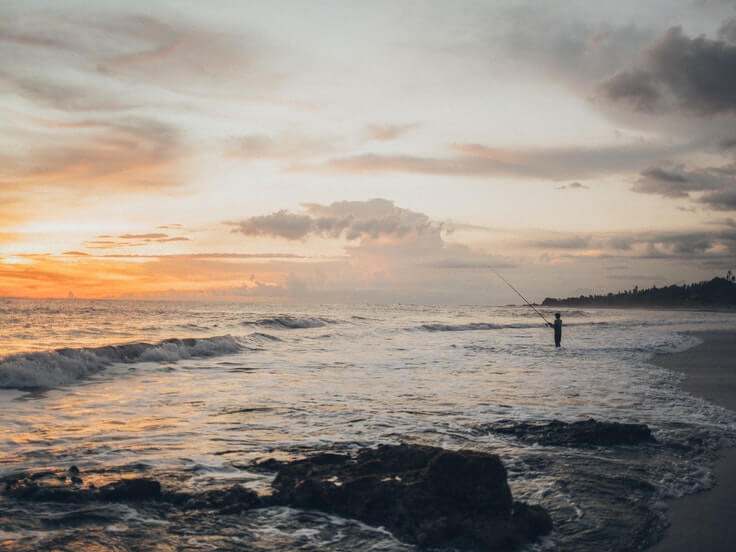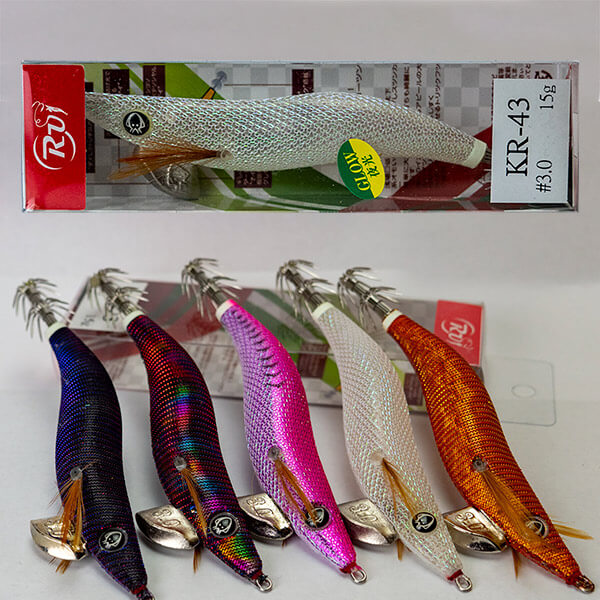 Photo credit: Paul Stowe
Photo credit: Paul Stowe
Cephalopods include several species of creatures that may seem a little odd at first glance, so you'll need very specific lures to target them, and the squid jig is one of them. Cuttlefish, squid and other species have a completely different structure to fish and a behaviour that can sometimes be disconcerting if you've never fished before.
Yet these species are fascinating to catch and to lure. The way they move, their attacks and their defences are quite simply unique. In fact, many anglers on all coasts often wait for the right time of year to catch a few.
The squid jig is a lure specially designed for cephalopod fishing. Its shape, design and various components are part of a genuine Japanese culture that has developed this type of lure over the years. While it may be fairly simple in our French approach, in Japan it is a real art, with almost infinite possibilities.
If you're a complete beginner in this discipline and want to fish exclusively for cuttlefish, we recommend that you start by reading our article Beginning cuttlefish fishing: our advice. You'll find a wealth of information perfectly suited to this very special sport.
What techniques should you use to catch cephalopods?
 Photo credit: Tackleland
Photo credit: Tackleland
There aren't many of them. It's more in the location or the way you present the concept of squid jig concept that you can vary the possibilities. But if we're talking about sport fishing here, we'll confine ourselves to that wonderful lure, the Squid jig.
This technique has a very special name: eging. It combines the search for cephalopods, cuttlefish and squid, with lures.
Products have been specially developed. These include rods, reels, braids and entire ranges of tackle and accessories for these species.
If you'd like more information on how to animate your lure from a boat, then you'll find what you're looking for in our article Fishing with squid jig from a boat? How it's done. You'll soon see that there are many subtleties that will make all the difference.
Where and how to fish?

As cephalopods can be found everywhere on the French coast, it's fairly easy to come across them if you look for them at times when they are present. Certain areas lend themselves more easily than others to their presence.
- The calm Mediterranean Sea, with its many creeks and inlets, is an easy place to find them.
- The same applies to the Arcachon Basin and the inland inlets, where you can practice from winter to summer.
You can fish from the shore or from a boat. If you know your fishing areas well, you can regularly catch cuttlefish and squid by moving your jigs at different depths and speeds. Don't forget to find out about the tides - our article Which tide for cuttlefish? deals in part with this subject.
Animation will be an essential part of your research and the success of your fishing trip. The Bichi Bachi requires a certain finesse and habit in the presentation of your lure. You'll always have to opt for hooks that don't look like hooks and animation close to the bottom when you're looking for cuttlefish or between two waters when it comes to squid.
For more information on this subject, see our article on how to animate a squid jig when fishing.
It's by repeating the technique that you'll gradually get the hang of it and learn how to handle, hook and react to your lure. We advise you to make your first outings during the day so that you have a visual of everything that happens during your animations and your bites.
You will then be able to feel comfortable with less light, perhaps with a bright line at first, to better appreciate the effect of the weight on the descent.
What type of jig should I choose?

This is a decisive factor in the success of your fishing. The choice is simply immense. And yet, France does not have the choice of what you might find in countries such as Japan.
There are several families of squid jig that you can use with varying degrees of effectiveness. We're going to take a look at the different technical characteristics of these lures and the different advantages they can offer.
- The first thing to consider is size. It needs to be well adapted to the cephalopods you are looking for. It also has to be consistent with what's in the water. Without this, you could fish for hours through numerous cephalopods while attracting absolutely no attention.
- The basket, which is a term for the hook, will have a particular profile to easily capture the tentacles. Different shapes are possible for each species. The body, meanwhile, will regularly be covered in fabric, but new models are coming onto the market with smoother structures that stand out.
- Finally, another essential element: weight. This is what will allow the lure to sink more or less quickly in the water column. In fact, you'll find indications not in grams but in numbers. These are referred to as size 1.0, 2.0 , 3.0 etc etc. The higher the number, the longer the squid jig will be and the faster it will go down.
The colour of your squid jig is, of course, the subject of much discussion. Here again, the possibilities are so numerous and the variations in mood so great that you should opt for a selection of several colours. This has the practical advantage of always having what you need at hand.
As a general rule, you'll opt for more natural colours, so that you can practice in daylight and at night. You'll need to opt for slightly different colours for sunrise and sunset. You'll want to go for violet, yellow, orange... and finally, you can opt for very bright colours, or even fluorescent colours for tinted water.
If you're looking to fish for cuttlefish at night, we recommend you read Night cuttlefish fishing: which colour to choose? This will give you all the information you need to make the right choice.
If you're a complete beginner and don't want to take on too much, here are a few models we can recommend from experience:
- The Squid jig Emeraldas Nude from Daiwa. A very popular model, it has a completely different look to the other lures in the Japanese brand's Emeraldas series. Available in a range of sizes and colours, this is an excellent choice for a very contained price.
- The squid jig Stingray Dart is the latest model from the French brand Sakura. It benefits from all the expertise the brand has acquired in recent years, including environmentally-friendly manufacturing using materials such as zinc instead of weight.
- Finally, we couldn't overlook one of the most emblematic brands in Eging fishing: Yo-Zuri. We recommend one of the latest models from the Japanese brand, the Squid jig Egi Aurie Q 3D 4.0 13cm, a jewel of a product. From the quality of its colours to its swimming performance, it's simply perfect. The price is slightly higher, but that's understandable when you're using it.
Discover all our lures Squid jig
As you can see, the world of eging or bichi bachi fishing is a world apart. You can keep it simple by practising from time to time at the right time of year with generalist equipment, or you can invest heavily in technique, rigging and philosophy to discover a Japanese art that is different from what you already know.
Don't forget to select the rest of your equipment carefully, for maximum performance. In fact, our article rod might be ideal reading if you want to understand what's involved in fishing at squid jig.
